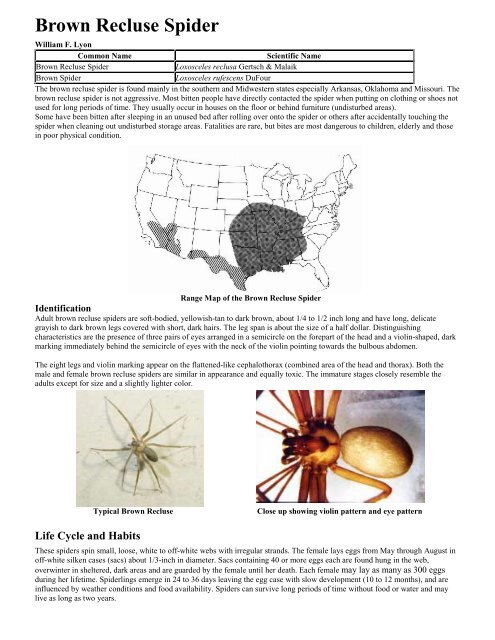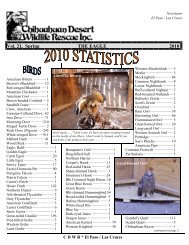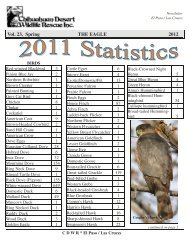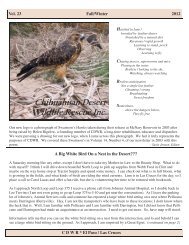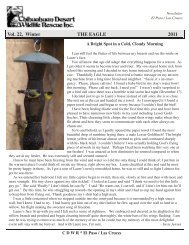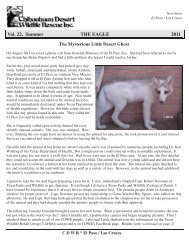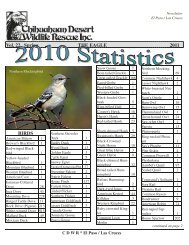Brown Recluse Spider
Brown Recluse Spider
Brown Recluse Spider
Create successful ePaper yourself
Turn your PDF publications into a flip-book with our unique Google optimized e-Paper software.
<strong>Brown</strong> <strong>Recluse</strong> <strong>Spider</strong>William F. LyonCommon NameScientific Name<strong>Brown</strong> <strong>Recluse</strong> <strong>Spider</strong>Loxosceles reclusa Gertsch & Malaik<strong>Brown</strong> <strong>Spider</strong>Loxosceles rufescens DuFourThe brown recluse spider is found mainly in the southern and Midwestern states especially Arkansas, Oklahoma and Missouri. Thebrown recluse spider is not aggressive. Most bitten people have directly contacted the spider when putting on clothing or shoes notused for long periods of time. They usually occur in houses on the floor or behind furniture (undisturbed areas).Some have been bitten after sleeping in an unused bed after rolling over onto the spider or others after accidentally touching thespider when cleaning out undisturbed storage areas. Fatalities are rare, but bites are most dangerous to children, elderly and thosein poor physical condition.Range Map of the <strong>Brown</strong> <strong>Recluse</strong> <strong>Spider</strong>IdentificationAdult brown recluse spiders are soft-bodied, yellowish-tan to dark brown, about 1/4 to 1/2 inch long and have long, delicategrayish to dark brown legs covered with short, dark hairs. The leg span is about the size of a half dollar. Distinguishingcharacteristics are the presence of three pairs of eyes arranged in a semicircle on the forepart of the head and a violin-shaped, darkmarking immediately behind the semicircle of eyes with the neck of the violin pointing towards the bulbous abdomen.The eight legs and violin marking appear on the flattened-like cephalothorax (combined area of the head and thorax). Both themale and female brown recluse spiders are similar in appearance and equally toxic. The immature stages closely resemble theadults except for size and a slightly lighter color.Typical <strong>Brown</strong> <strong>Recluse</strong>Close up showing violin pattern and eye patternLife Cycle and HabitsThese spiders spin small, loose, white to off-white webs with irregular strands. The female lays eggs from May through August inoff-white silken cases (sacs) about 1/3-inch in diameter. Sacs containing 40 or more eggs each are found hung in the web,overwinter in sheltered, dark areas and are guarded by the female until her death. Each female may lay as many as 300 eggsduring her lifetime. <strong>Spider</strong>lings emerge in 24 to 36 days leaving the egg case with slow development (10 to 12 months), and areinfluenced by weather conditions and food availability. <strong>Spider</strong>s can survive long periods of time without food or water and maylive as long as two years.
This spider is most active at night when it comes out in search of food consisting of cockroaches and other small insects. Duringthe day, time is spent in quiet, undisturbed places such as bathrooms, bedrooms, closets, basements and cellars. The spiderssometimes take shelter under furniture, appliances and carpets, behind baseboards and door facings, or in corners and crevices.Some have been found in stored clothing, old shoes, on the undersides of tables and chairs, and in folded bedding and undisturbedtowels stored for long periods of time. Outdoors, the spider may be found in sheltered corners among debris, in wood piles, underloose bark and stones, in old barns, storage sheds and garages. These spiders are very adaptable and may be active in temperaturesranging from 45 to 110 deg F.Bite SymptomsThe severity of a person's reaction to the bite depends on the amount of venom injected and individual sensitivity to it. Bite effectsmay be nothing at all, immediate or delayed. Some may not be aware of the bite for 2 to 8 hours, whereas others feel a stingingsensation usually followed by intense pain if there is a severe reaction. A small white blister usually rises at the bite sitesurrounded by a large congested and swollen area. Within 24 to 36 hours, a systemic reaction may occur with the victimcharacterized by restlessness, fever, chills, nausea, weakness and joint pain. The affected area enlarges, becomes inflamed and thetissue is hard to the touch. The spider's venom contains an enzyme that destroys cell membranes in the wound area with affectedtissue gradually sloughing away, exposing underlying tissues. Within 24 hours, the bite site can erupt into a "volcano lesion" (ahole in the flesh due to damaged, gangrenous tissue).The open wound may range from the size of an adult's thumbnail to the span of a hand. The sunken, ulcerating sore may healslowly up to 6 to 8 weeks. Full recovery may take several months and scarring may remain. Plastic surgery and skin grafts aresometimes required.Day 3 post-biteDay 4 post-biteDay 5 post-biteDay 6 post-bite
Day 9 post-bite Day 10 post-biteFirst AidIf bitten, remain calm, collect the spider, if possible, for positive identification and get medical attention immediately (contact yourphysician, hospital and/or Poison Information Center). Apply antiseptic solution to prevent infection and ice packs to relieve localswelling and pain directly to the bite area.An effective antivenom is not generally available. The physician will usually administer high doses of cortisone-type hormones tocombat hemolysis and other systemic complications. A report suggests that treatment with dapsone (a drug used mainly forleprosy) may reduce the degree of tissue damage.Control MeasuresThe brown recluse spider is not aggressive and normally bites only when crushed, handled or disturbed. It is aptly named since it isa reclusive creature seeking and preferring seclusion.PreventionShake out clothing and shoes before dressing, and inspect bedding and towels before using. People are most often bitten whenputting on clothing that has hung undisturbed or shoes seldom worn, into which a spider has moved. Do not go barefoot or handlefirewood without gloves.Remove trash, old boxes, piles of lumber, old clothing and other unwanted items. Eliminate cluttered areas in basements, closets,attics and other outbuildings.Dust and vacuum thoroughly and more frequently around windows, corners in rooms, under furniture, in storage areas andnormally undisturbed places to eliminate spiders, webs and egg sacs. Use a dust mop, broom and dust pan, if needed.Install screens on doors and windows to prevent entry. Seal or caulk cracks and crevices where spiders can enter the house. Washoff the outside of the house and roof eves.InsecticidesAdult spiders spend little time in direct contact with surfaces. Instead, they are found in or on webbing. Thorough applications offine particles of insecticides such as ULV, aerosols or fogs contact spiders in their webs causing quicker population reduction.Use space sprays of pyrethrins or resmethrin for useful clean outs, especially attics and crawl spaces.Thoroughly treat cracks and crevices of decorative molding, window and door trim and undersides of tables, chairs and shelveswith residual pesticides. Use Diazinon, or propoxur (Baygon) as a long-lasting residual treatment.Outdoors, spray around the perimeter of buildings using formulations that will not damage plants. Treat under eaves, patios anddecks if the house is of pier and beam construction. Baygon, Diazinon and permethrin are frequently used.There are many other labeled pesticides for spider control. Some are labeled for homeowner use, while others are labeled only forthe licensed, certified, pesticide applicator or pest control operator. Homeowners can use amorphous silica gel (Drione, Tri-Die),some formulations of bendiocarb (Ficam), chlorpyrifos (Dursban), and permethrin (Astro, Dragnet, Flee, Prelude, Torpedo);diazinon, esfenvalerate (Conquer), propoxur (Baygon), pyrethrin (Exciter, Kicker, Microcare, Pyrethrum, Safer, Synerold, Uld, X-Clude) plus resmethrin (Vectrin). In addition, the licensed pesticide applicator can use bendiocarb + pyrethrins (Ficam Plus),clyfluthrin (Optem, Tempo), cypermethrin (Cyper-Active, Cynoff, Demon, Vikor), deltamethrin (Delta Dust, Suspend),lambdacyhalothrin (Commodore), propetamphos (Safrotin) and tralmoethrin (Saga).Before using any pesticide, always read the label and follow directions and safety precautions.
This publication contains pesticide recommendations that are subject to change at any time. These recommendations are providedonly as a guide. It is always the pesticide applicator's responsibility, by law, to read and follow all current label directions for thespecific pesticide being used. Due to constantly changing labels and product registration, some of the recommendations given inthis writing may no longer be legal by the time you read them. If any information in these recommendations disagrees with thelabel, the recommendation must be disregarded. No endorsement is intended for products mentioned, nor is criticism meant forproducts not mentioned.


